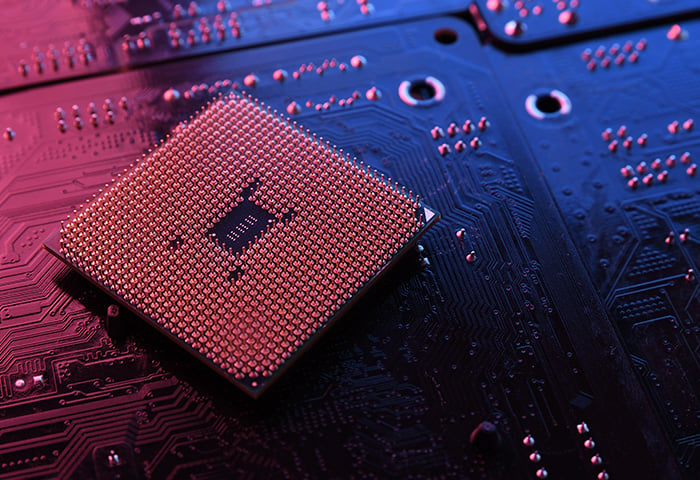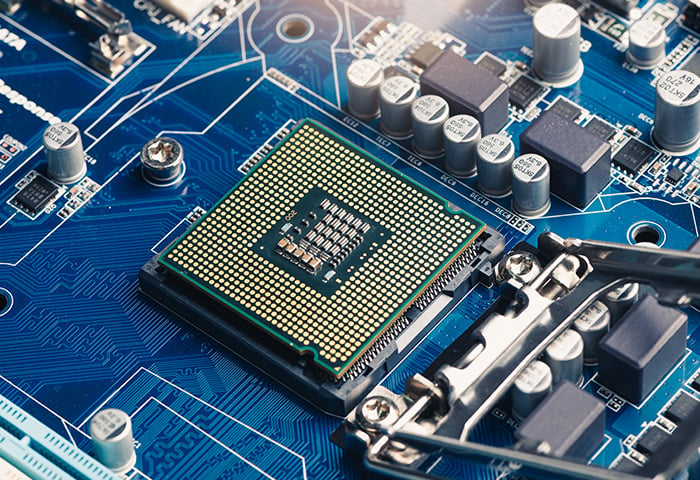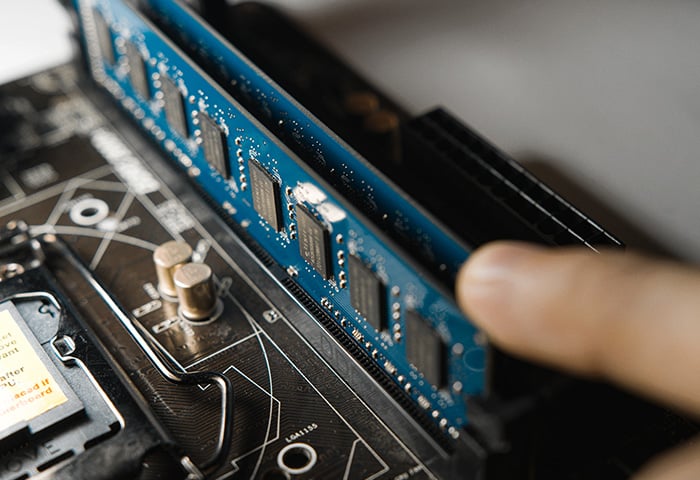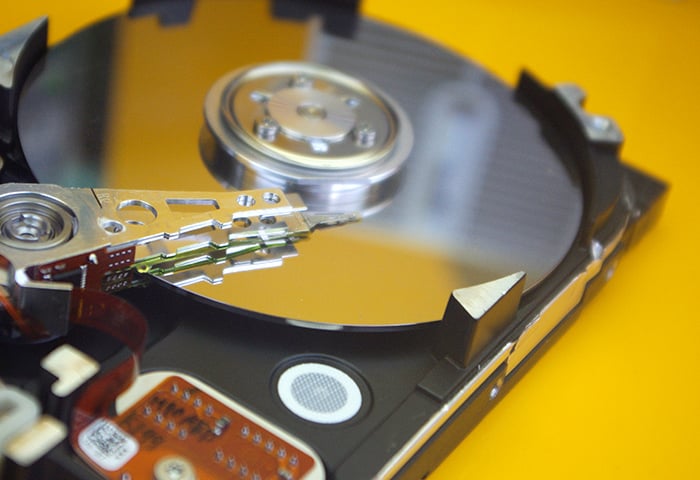What does SSD stand for?
SSD stands for solid-state drive, but what is a solid-state drive? The basic definition is a storage device with non-volatile memory that works much faster than an HDD. Unlike older hard-disk drives (HDD), SSDs don't have any moving parts, such as spinning disks or access arms that move around the disk.
For years, the physical mechanism of the hard-disk drive was the one thing standing in the way of faster read and write speeds. By reimagining the way data storage and access works, SSDs eliminate that problem, and now large files load much more quickly with an SSD than with an HDD. So, how do solid-state drives work?
How solid-state drives work
You probably know that all the data you've saved can be written as ones and zeros. But how can we squeeze trillions of those ones and zeros into a tiny phone that fits in the palm of our hand? How does solid-state technology work? Let’s dig into how SSDs get the job done.
What does an SSD do?
An SSD counts ones and zeros using electrons — particles that are even smaller than atoms. You can think of an SSD like an extremely dense abacus. The inside of an SSD is a system of microscopic transistor grids stacked on top of each other. The transistors are set to specific electrical charges, which in turn are changed and preserved with “gates.”
Control gates and floating gates alter the current flowing through the transistors to trap electrons in specific places. The gates can then read how many electrons are trapped there, providing a “1” or a “0” as an output. That’s how we read and write data from an SSD.
With everything organized into grids, information can be read much more quickly. No spinning disks or moving arms are needed — you just need to access the bit at row X, column Y. The setup allows an operating system like Windows or macOS to load much more quickly than it otherwise would if stored on an HDD.
The only real downside is that SSDs are considerably more expensive to produce, and so they’re more expensive to buy.
What are the components of an SSD?
On the outside, an SSD looks just like an HDD — because it’s been made to be conveniently interchangeable with what most computers are already using. But the physical size of SSDs can vary. In fact, many SSDs offer tons of storage space at only a fraction of an HDD's size.
 The development of computer storage technology, from HDDs to SSDs.
The development of computer storage technology, from HDDs to SSDs.
Inside, an SSD looks like a circuit board with computer chips. The main chips are the flash controller and the memory chip(s). The flash controller sends voltage down the wire to a group of cells in the memory chip, corralling the electrons into the correct gates.
The memory chip is an enormous library of cells that holds millions of electrons captive in a specific order. The flash controller reads that order by checking the charge of each cell. It then processes the information for the host computer to read.
There’s more to it than this basic summary. To understand what else is going on under the hood, let's consider the history of solid-state drives.
A brief history of the SSD
Dynamic RAM-based SSDs were already in use in the early 1990s, mainly for large-scale server centers. But the use of volatile memory in these drives meant that data would be wiped if the drives were turned off — not exactly ideal for home computing.
In 1995, the Israeli company M-Systems developed the first modern SSD, though at the time such cutting-edge technology was good only for military applications. The turn of the century brought the use of flash technology into consumer-grade digital cameras, capable of holding a few dozen megabytes' worth of photos.
It wasn't until 2006, when Samsung released a flash SSD with wear-leveling technology, that the new storage system started to become viable for use in home computers.
But it wasn't until 2006, when Samsung released a flash SSD with wear-leveling technology, that the new storage system started to become viable for use in home computers. Before that time, devices wore out much more quickly. A memory cell can be written to only so many times, and the new, wear-leveling technology prioritized unused memory cells.
Wear-leveling combines with garbage collection to optimize how SSDs work. Saving a modified file onto an SSD with wear-leveling creates a new file elsewhere on the drive, while the old version exists in its original location. Garbage collection regularly reorganizes information across the drive, removing obsolete data. That’s important because SSDs have to rewrite entire blocks when writing data, and old data slows down the process.
These days, SSDs have become more robust — and their price is dropping as well — making them suitable alternatives to HDDs.
Choosing an SSD
SSDs are generally much faster than HDDs. But how do these newer devices compare with one another? Which SSDs are the fastest? And how much power in your computer do you really need?
More importantly, which SSDs will work with your computer? Let’s take a look at some aspects to consider before buying.
Storage interfaces
You'll want to pay attention to the storage interface of SSDs for their form factor (a fancy way to refer to their size and shape), compatibility, and performance. Let’s take a look at some SSDs geared toward personal computing, followed by more advanced SSDs that are used in industrial applications.
Traditional SSDs, including mSATA III and SATA III
-
SATA: SATA was the standard storage interface for many years, and early consumer SSDs were built to match what most people already had. These drives are often shaped like HDDs so that you can easily install them into most personal computers without any issues — and the bandwidth throughput of around 500 MB per second will feel lightning-fast for most users.
-
SATA III: This third-generation drive is now the most common type, as the first and second generations have long since gone out of use.
-
mSATA: These drives offer similar performance in a smaller form factor. They’re great for laptops, but they aren't compatible with every device.
As SSDs have become more powerful, it’s time to move beyond SATA. So let’s take a look at interfaces that take full advantage of solid-state technology.
 Three types of storage interface: an m.2, SSD, and SATA drive.
Three types of storage interface: an m.2, SSD, and SATA drive.
PCIe and NVMe SSDs
Whereas SATA was adapted from HDD technology, PCIe and NVMe were optimized and built from the ground up specifically for SSD use. SATA's limitations were never a problem when the hard drives themselves had limited capabilities. But now that storage devices can send data at much faster rates, SATA drives struggle to keep up.
-
PCIe 4.0: Peripheral Component Interconnect Express (PCle) interfaces typically handle graphics cards – in other words, they handle powerful, high-speed components. They transmit at speeds that leave SATA in the dust — SATA maxes out at 500 MB per second, whereas PCIe 4.0 can hit 32 GB per second. That’s much more in line with an SSD’s capabilities. It makes sense to use the type of port that can handle what SSDs are dishing out!
-
PCIe 5.0: The latest version of the PCIe interface is even more advanced than PCIe 4.0, with twice the data transfer bandwidth potential. Theoretically, this means they enable better SSD performance. However, in practice, they rarely offer a tangible benefit because the PCIe 4.0 interface already offers enough bandwidth to comfortably accommodate most hardware.
-
NVMe: Non-Volatile Memory Express (NVMe) is a new type of transfer protocol that takes advantage of an SSD's unique capabilities. Imagine you've got the newest storage technology on the market, but your computer is making it transmit data on one lane like some dusty old HDD your grandparents would use. Wouldn't you want the SSD to run that data across a dozen or more lanes, like it's supposed to? That's why NVMe has been replacing the older AHCI protocol. Even better, it connects via the PCIe interface we discussed above.
With prices dropping every year, NVMe is fast becoming the new standard. And unless you’re on a tight budget, there’s no reason to choose a SATA SSD over an NVMe drive.
Choosing the right type of memory
You might look at an SSD’s product description and see terms like NAND or single-level cell (SLC). These are important because they directly impact the everyday use and longevity of your SSD. Let’s take a look at what they entail.
 Three types of flash memory in SSDs: single-level cells (SLC) with one bit per cell, multi-level cells (MLC) with two bits per cell, and triple-level cells (TLC) with three bits per cell.
Three types of flash memory in SSDs: single-level cells (SLC) with one bit per cell, multi-level cells (MLC) with two bits per cell, and triple-level cells (TLC) with three bits per cell.
Single-level cell (SLC)
In SLC memory, a single bit is written to each cell. These are the most expensive SSDs, because they are the fastest, most durable, and most reliable. But the cost per gigabyte is much higher, since each cell can hold only one bit.
Single-level cell SSDs outlast the others by several years. Their track record for reading and writing data without errors has made them the SSD of choice for large-scale, multi-server operations.
Multi-level cell (MLC)
Multi-level cell SSDs carry two bits per cell, meaning there’s twice as much data to process in the same amount of space. That means read and write times will be a little slower.
Triple-level cell (TLC)
Triple-level cells have three bits of information per cell, making them even slower and less reliable. But this is generally the standard for consumer-grade SSDs, because they last for years, and the performance improvement over HDDs is immense.
NAND or 3D V-NAND?
The original layout for SSDs, NAND consisted of memory cells arranged on a flat surface. As technology improved, manufacturers could jam more and more cells onto their SSDs — but only up to a point. The cells were crammed so tightly together that they began to interfere with one other, causing errors and data loss. It seemed that storage space had reached its limit.
3D V-NAND (or just V-NAND) arranges cells vertically, so potential storage space is much larger. The line segments rise like apartment buildings (rather than spreading out like suburban houses), so many more cells can fit on the same surface area. Additionally, manufacturers no longer have to painstakingly carve out space on the cell’s surface to make everything fit, which lowers production costs considerably. You shouldn’t have much trouble choosing between these options: 3D V-NAND is less expensive, performs better, and lasts longer.
What are SSDs used for?
SSDs have specialized applications, and we haven’t quite reached the point where they’re the best option for everybody. Keep in mind that a traditional hard disk drive might be far more practical for you. Before buying, make sure you know your answer to the question: “What is an SSD for?”
Data storage for businesses
Whether a business employs a team of 10 or 10,000, the consequences of data loss or file storage failure can be disastrous. That's why more and more businesses are opting for storage solutions that take less time to back up.
And increased productivity usually means higher profits and better operations for a business as a whole. The minutes that companies save when extracting data from an SSD vs. an HDD certainly add up. SSDs are also more shock-resistant, while less power consumption lowers the electric bill.
Improving gaming performance
Everybody's got that friend who lives for gaming. They may optimize their PC for speed and cleanliness. Or they may have switched to solid-state technology long ago. And you might be wondering why.
The difference is mainly in load times: SSDs have much shorter load times than HDDs. But once gameplay starts, the storage drive's work is done, and that's where the advantages of an SSD end. Everything else is up to the graphics card and processor. In other words, don't expect your frame rate to improve with an SSD.
The PlayStation 4 was arguably the most powerful gaming console of its generation — and it used a hard drive. Even the PS4 Pro, the beefed-up 2016 version, used a hard drive. HDDs are still quite capable of running powerhouses such as Ark: Survival Evolved, Grand Theft Auto V, and Dark Souls.
Still, shorter load times are a great reason to upgrade to an SSD. For the PC gamer trying to build the ultimate machine, the answer’s clear: the base PlayStation 5 and Xbox Series X models both ship with SSDs. The times are changing: Load-time benchmarks will soon be determined by solid-state technology, putting HDDs at a huge disadvantage.
No matter what type of drive you have, you won’t get optimal gaming experience if it’s full of clutter. AVG TuneUp performs regular maintenance like removing unwanted programs and junk files, ensuring your machine always runs buttery smooth.
Enterprise servers
Enterprise servers are relied upon by thousands, even millions of users. For these servers to be useful tools, they need to respond quickly and efficiently. System failure and data loss can’t be tolerated, and regular backups should take up as little time and power as possible.
That makes state-of-the-art SSDs the most capable solutions when it comes to enterprise-server storage. They can read and write data much faster than HDDs, and the most durable of them last many years longer. These drives also use up less power and are less sensitive to the elements. That’s where an HDD — with its clumsy access arm and single-lane SATA transfer protocol — simply fails to measure up.
Should I be using a solid-state drive?
If your work involves bulky programs and huge file sizes, then yes, you should use an SSD. If you’re often stuck waiting for a file to save or load, then definitely yes.
But there’s a trade-off with storage space. Though prices are dropping, an SSD can cost more than twice as much as an HDD with the same storage capacity. So you should consider if the benefits of an SSD are worth that extra cash. For example, an SSD can drastically cut the time it takes for Photoshop to do certain tasks. Paying double for a device that will reduce waiting time to a fraction of what it would otherwise be is usually a pretty good trade-off.
But if you're just looking to store personal files, you might want to reconsider. When most programs you use already load and save files in seconds, it’s hard to justify the added cost. And while the lack of moving parts can extend the life of your data, SSDs are not perfect. They too will eventually fail, and it may not be reasonable to factor a longer lifespan into this equation.
For most of us, buying a 1TB HDD is arguably a better deal than shelling out the same amount of money for a 250 GB SSD. We don’t need the most advanced technology — just a computer that will get the job done.
What's the difference between an SSD and a HDD?
We’ve already mentioned that SSDs don’t have any moving parts, but why does that matter? Let's look at a common storage format which does have moving parts: the hard-disk drive (aka the hard drive or HDD). Unless you’ve built your own PC or recently bought a brand-new computer, you’ve likely got an HDD in your desktop or laptop.
 Comparing the difference in size of an SSD M.2 drive with two different HDD drives.
Comparing the difference in size of an SSD M.2 drive with two different HDD drives.
A hard drive is a spinning disk. To access a file, the disk spins and the access arm reads the data on it. Your files may be neatly organized into folders, but that data is scattered across different parts of the disk. That's why the arm has to comb through a lot of data to find what it wants.
Solid-state drives work much more quickly, because every point in the system of grids is immediately accessible at any time. They’re also more durable — if you bump the hard drive and knock the disk loose from its platter, you can lose everything. It's a delicate system, and it's why we tend to be careful with our laptops.
But most of us use our HDDs for years at a time, so durability isn’t an issue. In fact, both formats will last several years under normal use.
But there are still practical questions about the benefits of an SSD vs. HDD, such as:
-
Do I move large files often?
-
Would I materially benefit from shorter load times?
-
Am I willing to buy a more expensive drive?
One thing that hasn’t changed with the transition to solid state is the need for regular maintenance. That means keeping your programs updated, clearing out clutter in your registry, and removing browser cache files. Doing this yourself can be a hassle, as temporary files build up constantly. Luckily, there’s one program that can do all of this for you: AVG TuneUp. Whether you use an SSD or an HDD, make sure you get the most out of it with AVG TuneUp.
Improving the performance of your SSD
Just like HDDs, SSDs need regular maintenance. Some of it is done automatically by the firmware in the flash controller as well as by your operating system, but there’s more you can do to extend the lifespan and increase the speed of your SSD.
-
Leave some space free. This will keep the ratio of unused space to used space at a reasonable level, giving the drive more unused space to write to. Overwriting used space in an SSD takes a few more steps and a little bit longer, and you want to avoid 100% disk usage issues.
-
Update the firmware. Your SSD might have a bug preventing it from executing a necessary process to ensure proper maintenance. Make sure to google the make and model of the drive in case there's been an update to fix the bug.
-
Make sure TRIM is enabled. TRIM is an essential process that helps clear out old data, and it's probably already turned on. But it can't hurt to double-check.
-
Enable AHCI mode. Going into your BIOS and checking if AHCI mode is enabled (not IDE) will ensure that you’re getting the most out of your SSD. But if you’re not sure what you’re doing, definitely leave this step to an expert.
-
Use a cleaning tool. A drive can’t do its job if it’s got temporary files and unused programs clogging up space. A dedicated cleaning tool like AVG TuneUp is a great way to remove and prevent clutter, increase speed and performance, and extend the life of your computer.
Boost performance further with AVG TuneUp
AVG TuneUp knows exactly what your SSD needs. It's designed to identify problems that slow down your device and nip them in the bud. Say goodbye to bloatware, browser cache files, and unneeded background apps. Treat your SSD to AVG TuneUp today and experience dramatic improvements in the speed and reliability of your computer.

 The development of computer storage technology, from HDDs to SSDs.
The development of computer storage technology, from HDDs to SSDs. Three types of storage interface: an m.2, SSD, and SATA drive.
Three types of storage interface: an m.2, SSD, and SATA drive. Comparing the difference in size of an SSD M.2 drive with two different HDD drives.
Comparing the difference in size of an SSD M.2 drive with two different HDD drives.













